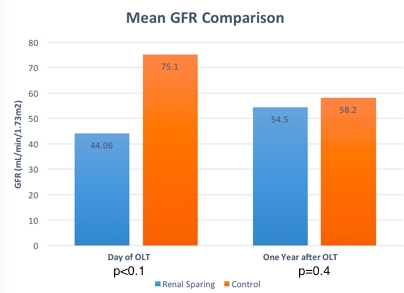Outcomes in Liver Transplant Patients on Renal Sparing Protocol
1New York Medical College, Valhalla, NY
2Comprehensive Transplant Center, Northwestern University, Chicago, IL.
Meeting: 2018 American Transplant Congress
Abstract number: D216
Keywords: Calcineurin, Immunosuppression, Nephrotoxicity, Renal function
Session Information
Session Name: Poster Session D: Liver - Kidney Issues in Liver Transplantation
Session Type: Poster Session
Date: Tuesday, June 5, 2018
Session Time: 6:00pm-7:00pm
 Presentation Time: 6:00pm-7:00pm
Presentation Time: 6:00pm-7:00pm
Location: Hall 4EF
As liver transplant outcomes have improved, long term native kidney function has taken a critical role in patient survival. Calcineurin inhibitors (CNIs), such as Tacrolimus (FK), have been mainstays of immunosuppression after OLT; however, CNIs are also known to have nephrotoxic properties that can lead to irreversible and progressive tubule-interstitial injury and glomerulosclerosis. A renal sparing (RS) approach by delaying and minimizing CNI exposure and adding a non-CNI immunosuppressive agent such as mycophenolate mofetil (MMF) or mTOR inhibitor has been developed at our center for a pre-determined at risk population. We hypothesize that using the RS approach will increase renal outcomes at 1 year post-OLT.
This is a retrospective study of patients who underwent OLT from 1/2010-5/2016. Patients were divided into a pre-determined at risk RS group (n=43) and control group (n=71). The renal sparing therapy includes initiation of MMF and steroids post-OLT day 1 with delayed FK. The control group received FK and steroids on post-OLT day 1, and eventually given MMF. Primary study outcome was GFR at 1 year post-OLT measured using CKD-EPI formula.
GFR on day of transplant in the RS group was lower (p<0.01) than in the control group; however, GFR at 1 year in the two groups was similar (p=0.4).  The change in GFR from the day of transplant to 1 year in the RS group (9.62 ± 41 mL/min/1.73m2) was significantly greater (p<0.01) than the control group (-16.9 ± 29 mL/min/1.73m2). Baseline characteristics and pre-OLT comorbidities were similar (p>0.5) between the two groups. FK levels in the RS group (7.22 ± 4.7 ng/mL) were similar to the control group (7.39 ± 3.6 ng/mL). Adverse events such as rejection, NODAT, Malignancy, CMV, bacteremia, and death were similar (p>0.5). Neutropenia in the RS group (20/43) occurred significantly more (p=0.02) than in the control group (17/71).
The change in GFR from the day of transplant to 1 year in the RS group (9.62 ± 41 mL/min/1.73m2) was significantly greater (p<0.01) than the control group (-16.9 ± 29 mL/min/1.73m2). Baseline characteristics and pre-OLT comorbidities were similar (p>0.5) between the two groups. FK levels in the RS group (7.22 ± 4.7 ng/mL) were similar to the control group (7.39 ± 3.6 ng/mL). Adverse events such as rejection, NODAT, Malignancy, CMV, bacteremia, and death were similar (p>0.5). Neutropenia in the RS group (20/43) occurred significantly more (p=0.02) than in the control group (17/71).
Delayed initiation of CNI agents post OLT, along with a lower target FK trough may lead to improved renal outcomes at one year for all OLT patients, with no change in risk of graft rejection or infectious complications when MMF is used as additional immunosuppression.
CITATION INFORMATION: Polyak A., Ganger D., Shetty A. Outcomes in Liver Transplant Patients on Renal Sparing Protocol Am J Transplant. 2017;17 (suppl 3).
To cite this abstract in AMA style:
Polyak A, Ganger D, Shetty A. Outcomes in Liver Transplant Patients on Renal Sparing Protocol [abstract]. https://atcmeetingabstracts.com/abstract/outcomes-in-liver-transplant-patients-on-renal-sparing-protocol/. Accessed December 18, 2025.« Back to 2018 American Transplant Congress
